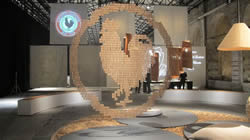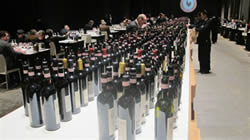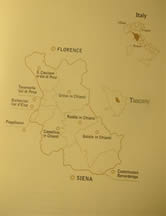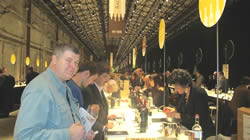 The event that opened yesterday with each journalist given his own private tasting area and a personal sommelier (actually each one looks after four guests), carting 6 bottles at a time of one’s choice selected out of a list of 293 wines, starting from 2009 and going on to 2008, 2007, 2006. Riserva range is also available for the very young 2009, 2008, 2007, 2006, 2005 and even a couple of 2004. Naturally, quite a few of the younger wines from both categories have been bottled specially for the tasting from the barrels where the wine is still maturing. The event that opened yesterday with each journalist given his own private tasting area and a personal sommelier (actually each one looks after four guests), carting 6 bottles at a time of one’s choice selected out of a list of 293 wines, starting from 2009 and going on to 2008, 2007, 2006. Riserva range is also available for the very young 2009, 2008, 2007, 2006, 2005 and even a couple of 2004. Naturally, quite a few of the younger wines from both categories have been bottled specially for the tasting from the barrels where the wine is still maturing.
The event also highlighted how we are not the only people in Delhi to suffer the vagaries of fog. Two of the journalists Debra Meiburg MW from Hong Kong and Tim Aitkin MW from UK reached early afternoon. Reason- their flight to Florence could not land in the morning fog and had to be diverted to Verona from where the 2-hour coach journey brought them to the venue. One also wonders after landing at the small, over-crowded Florence airport with inexplicable slow baggage handling and where everyone feels slightly suffocated, that it is time perhaps for India with the experience at Mumbai and Delhi, to offer them a consultancy proposal to modernize the airport, needed so badly.
The program for the second day includes meeting and tasting with the producers, including the barrel samples of 2010 vintage which is considered to be an excellent vintage so far. As reported in delWine last year, Tuscany had passed a measure on August 2, 2010 specifically asking the Chianti Classico producers to decrease their production by 20% to counter the problem of excess supply resulting from the recession of the last couple of years. Alcohol level is expected to be marginally higher.
 Where-ever there are two Indians-or Italians, arguments and disagreements are bound to take place, with a varying degree of passion. Same is the case with the Collection 2011 which for the first time has decided to showcase the IGT wines- the Super Tuscans which do not meet the Chianti Classico regulations but the enterprising producers have been marketing nevertheless as IGT wines, showcasing their ingenuity and winemaking skills to a wider appreciative audience. Where-ever there are two Indians-or Italians, arguments and disagreements are bound to take place, with a varying degree of passion. Same is the case with the Collection 2011 which for the first time has decided to showcase the IGT wines- the Super Tuscans which do not meet the Chianti Classico regulations but the enterprising producers have been marketing nevertheless as IGT wines, showcasing their ingenuity and winemaking skills to a wider appreciative audience.
As Marco Pallanti, President of the Consorzio Vino Chianti Classico explained to the journalists yesterday, the facility was being offered only to the members of the Chianti Classico Consortium (not for other Super Tuscan areas like Maremma) and a maximum of one label was allowed to be tasted on the 16th February. But some of the members have been vociferously opposing the idea, he admitted. It would be interesting to see if this tasting becomes a tradition; the vast majority of visiting journalists, especially non-Italians would favour the opportunity to taste the different expression of the terroir.
Central Italy is home to Sangiovese grape and till date no other country has been able to duplicate the quality of Tuscan varietal because of the terroir- even the highly regarded Vino Nobile di Montepulciano and Brunello di Montalcino arguably use a superior clone of this varietal. According to the new laws, 80-100 % Sangiovese must be used in Chianti Classico and the rest may be the approved indigenous varietals like Canaiolo (most common) and Colorino or the international varietals like Merlot and Cabernet Sauvignon. Earlier allowed white varietals like Trebbiano de Toscana and Malvasia Bianca, limited to 6%, are not permitted since 2006.
The 25,000 acres of planted vineyards have over 70% registered as Chianti Classico (17,500 acres). The annual production of 265,000 hL finds the biggest buyer in the US (27%) with the domestic market being next at 24%. Surprisingly Germany is the third largest consumer with 12% of the production being absorbed by the generally price-conscious market. Canada (8%), Switzerland (7%) and UK (7%) are also fans of Chianti Classico.
 Chianti Classico is an independent appellation since 1996 and has 9 sub-zones (see map) that one might find a mention of, on the label. Each has its own terroir specific wine and thus offers unique flavours- San Casciano Val di Pesa, Greve in Chianti, Tavarnelle Val di Pesa, Poggibonsi, Castellina in Chianti, Radda in Chianti, Gaiole in Chianti and Castelnuovo Berardenga at the southern boundary. Chianti Classico is an independent appellation since 1996 and has 9 sub-zones (see map) that one might find a mention of, on the label. Each has its own terroir specific wine and thus offers unique flavours- San Casciano Val di Pesa, Greve in Chianti, Tavarnelle Val di Pesa, Poggibonsi, Castellina in Chianti, Radda in Chianti, Gaiole in Chianti and Castelnuovo Berardenga at the southern boundary.
Another addition this year has been the presence and tasting of Chianti Classico DOP Olive Oil. The region has been making small quantity of excellent but expensive olive oil- around 150,000 liters have been harvested in 2010, according to an estimate by the Consortium-Consorzio Olio DOP Chianti Classico. About 36% of production is exported to Europe while the rest of the world including Brazil and China imports around 24%, the balance being consumed in the domestic market, presumably within Tuscany. For more info contact the Consorzio directly .
The purpose of the Collection is not necessarily to discover and brand the best wines, but to showcase the new vintages so the comparisons with previous years are in order and enough buzz is created in the industry overseas. I found the 2009 vintage light on the feet but very dexterous. The wines were generally seductively perfumed and elegant. One hopes they maintain their elegance and slight feminineness.
The 2008 were generally quite drinkable now-some had slight rough edges as might be expected. The 2007s were well rounded and ready to drink. However, matching with food, I found the flavours clashing with pasta and the chicken dishes in the light lunch. Melanzano-the Tuscan dish made from Aubergines (brinjals/eggplant) was a perfect pair. Even potato salad with ham was a great accompaniment as was the ever-popular Parmigiano Reggiano cheese. Riservas from 2009 and 2008 are still very young but a majority of 2007 are ready to drink with 2006 showed mostly well rounded wines, a majority of which were serious food wines that would show off better in the company of properly matched food.
 The Chianti Classico producers are cautiously upbeat and feel that the worst is behind them with the 2010 sales recording 21% increase over the disastrous 2009. The increase accelerated in the second half of 2010, with a growth of 37% compared to the same period in the previous year; the lift off was an astounding 55% during the last quarter of 2010, making all producers quite optimistic from this year on. The Chianti Classico producers are cautiously upbeat and feel that the worst is behind them with the 2010 sales recording 21% increase over the disastrous 2009. The increase accelerated in the second half of 2010, with a growth of 37% compared to the same period in the previous year; the lift off was an astounding 55% during the last quarter of 2010, making all producers quite optimistic from this year on.
Following are some of the wines tasted, that were outstanding. This may not reflect all the wines offered- it would be difficult for anyone to taste all the 293 wines in a day (with the 2010 barrel samples and the IGT wines, there are over 400 wines to taste!). Ask any of the 350 bottler members of the Consorzio (with a total of 570 members) and he will agree that being selective is the key to events like this:
| 1. |
Badia a Coltibuono 2009 |
 |
| 2. |
Isole e Olena 2009 |
 |
| 3. |
Querciabella 2009 |
 |
| 4. |
Barone Ricasoli- Colledilá 2008 |
 |
| 5. |
Castello di Albola 2008 |
 |
| 6. |
Fonterutoli 2008 |
 |
| 7. |
Brancaia 2008 |
 |
| 8. |
Castello do Volpaia 2008 |
 |
| 9. |
Principe Corsini 2008 |
 |
| 10. |
San Felice 2008 |
 |
| 11.. |
Castello di Ama-Bellavista 2007 |
 |
| 12. |
Castello di Ama-Casuccia 2007 |
 |
| 13. |
Pruneto 2007 |
 |
| 14. |
Bibbiano- Capannino 2008 Ris. |
 |
| 15. |
Felsina Rancia 2008 Ris. |
 |
| 16. |
Le Fonti 2008 Ris. |
 |
| 17. |
Castellare di Castellina 2008 Ris. |
 |
| 18. |
Castello di Qureceto 2007 Ris |
 |
| 19. |
Fontodi-Vigna al Sorbo 2007 Ris. |
 |
| 20. |
Val delle Corti 2007 Ris. |
 |
Subhash Arora
Florence, February 16, 2011
|